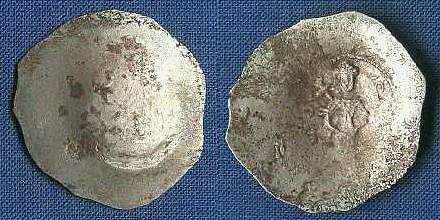|
|
|||||
 |
|
Theodore Mangaphas was a local magnate in the territory of Philadelphia in Asia Minor, who twice usurped control of that region, firstly in 1188-89, and again in 1204-05. Recently I acquired an example of the billon trachy issued by Mangaphas (cf. Grierson 1126, CLBC 9.2.1.B), and after cleaning it with a mild acid it became clear that this coin appeared to be clad in a silver coating of some sort. Now it is well known that pickling billon coins can dissolve copper from their surface layers leaving the coins with a silvery sheen, and this is possibly what has happened here. On the other hand the silver coating here is relatively thick, and does not appear in the corrosion pits, where the underlying copper surfaces can be seen, and so it seems unlikely to be simply the result of cleaning. Nor is it recently applied (as with some offerings of Byzantine coins from this period) as it only became apparent after some cleaning, before which the coin had the bright reddish-brown appearance typical of a number examples of this type, with no sign of the silvering. Since I am unaware of any reports of silvering on the coins of Mangaphas, I reproduce pictures of this new coin below. (Note that the pinkish tinge in some areas of the image is an artefact of the image processing - the actual colour is a matt silver grey on copper brown).
A Silvered Trachy of Theodore Mangaphas? (4.19g). The coating is partially worn off, but is still surprisingly thick in some places, even showing some cracking. I say surprising, since while the silvering on the earlier official billon trachies of Alexius I and John II at Constantinople was often quite thick, by the time Mangaphas issued his coins (during his first reign), the coating on the official types of Manuel I and Isaac II was generally very thin. I have little doubt that the coating of the earlier official types at least was composed of some low melting point alloy of silver, copper and tin (or zinc), and conceivably the same coating may have been used on Mangaphas's coins. In the case of the early 12th century official types it appears that the coating was added after striking, since it quite often obscures the design, and at first sight this seems also to be the case with the Mangaphas coin here. This new coin is important because according to the chronicler Nicetas Choniates, Mangaphas had issued "silver" coins, and it used to be thought that he was referring to the unique "electrum" trachy, of a similar design to one of Mangaphas's billon types, in the Barber institute in Birmingham. However, now it seems that the Barber coin is not actually electrum (Bendall, N. Circ. 2002, p.187)*, and Choniates' report has been doubted, but the new coin suggests that he may have been referring to silvered "billon" coins. This raises a very interesting question, namely, were all of Mangaphas's coins silvered?**. It would seem not, since, as far as I know, most of the examples of Mangaphas's coins that we see today show no signs of any silver coating at all. Also, according to Metcalf and others, the actual silver content of the alloy in the Mangaphas types is negligible, which is rather surprising, since we might have thought that melted down official coins, which at this time had a minimum of c.3.0% silver, would have been the first choice for the metal for these types (assuming they are in fact 12th cent. issues, as the hoard evidence attests). Perhaps the general lack of silver both in and on the Mangaphas types explains why this coinage found little use outside Philadelphia, in spite of the fact that die statistics suggest that it was actually quite extensive. It seems therefore that the Mangaphas coins were issued primarily for local use, although perhaps some were silver coated for external trade purposes. Or maybe the present coin was simply a contemporary fraud of some sort. * The Barber coin has the same design and large dies as Gr. 1127, the rarer of the two "billon" types of Mangaphas, as opposed to the commoner version Gr. 1126. It is said by its curator to be "yellowish" and may simply be a brassy copper - anyway, whatever it is actually made of, it seems not to be silver or silver coated. ** As far as I know this obvious question does not seem to have raised before. P.S. I am aware that this type is attributed, not without some justification, to Peter IV of Bulgaria (1185-97) by Bulgarian numismatists, but for the moment I will stay with the conventional attribution to Mangaphas.
Ross Glanfield April 2008 Latest revisions: 4 Dec. '08: Question of general silvering of Mangaphas coins raised.
|
|
|
